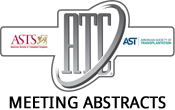2017 American Transplant Congress
Lower Mean Tacrolimus Troughs Increase Risk of De Novo Donor-Specific Antibodies in the First Year of Kidney Transplant.
University of Colorado, Aurora, CO
Development of de novo donor-specific antibodies (dnDSA) is the first step in the evolution of antibody-mediated rejection, which constitutes the leading cause of death-censored graft…2017 American Transplant Congress
Multicenter Validation of a Clinicopathologic Risk Score to Predict Hepatocellular Carcinoma Recurrence Following Liver Transplantation: Analysis of 4984 Patients from the US Multicenter HCC Transplant Consortium.
Objective: Recurrence of hepatocellular carcinoma (HCC) following liver transplantation (LT) negatively impacts survival. Existing risk prediction models either lack external validation or limit their scope…2017 American Transplant Congress
Redefining Pediatric Heart Status 1A and 1B Criteria: Results of Early Policy Evaluation.
Background. On March 22, 2016, changes to the definitions of pediatric Status 1A and 1 B criteria were implemented in the US. These changes were…2017 American Transplant Congress
Incidence of De Novo Donor-Specific Antibodies Following Kidney Transplantation.
With a range of frequencies reported in several small studies, true incidence of de novo donor-specific human leukocyte antigen (HLA) antibodies (dnDSA) is unknown. As…2017 American Transplant Congress
Molecular Profiles of Renal Allograft Biopsies at 12 Months Post Renal Transplant in Patients Exposed to Low Dose CNI and Everolimus vs. Patients Exposed to Full Dose CNI and MMF.
CNIs serve as the cornerstone of immunosuppression (IS) after kidney transplant. However chronic CNI nephrotoxicity has been implicated in allograft dysfunction. We hypothesize that lower…2017 American Transplant Congress
Genome-Wide Genotyping in 1022 Heart Transplantation Recipients & 758 Donors Reveal Association with Acute Allograft Rejection.
Introduction: Acute rejection (AR) in the 1st year post-cardiac transplant remains a significant clinical issue, and predisposes recipients to subsequent chronic allograft vasculopathy. Genetic factors…2017 American Transplant Congress
Potential Mechanism Involving Regulatory T Cells in Induction of Tolerance in Mouse Vascularized Composite Allotransplantation Under Combined Costimulation Blockade.
Background: Role of Regulatory T cells in vascularized composite allotransplantation (VCA) remains to be elucidated. In this study, we investigate potential mechanism involved in Tregs…2017 American Transplant Congress
Increase in Post-Transplant Mortality Under KAS.
Following implementation of the Kidney Allocation System (KAS), a major change to deceased donor kidney allocation in December 2014, transplantation rates increased for African-Americans and…2017 American Transplant Congress
Organs with Extended Cold Ischemia Time May Offer Aged Kidney Transplant Recipients New Options in an Expanded Donor Pool.
Using data from the largest cohort of renal transplants, the aim of this study was to examine the effects of cold ischemia times (CIT) on…2017 American Transplant Congress
A Multi-Center Experience of Direct Acting Anti-Viral Agents in HCV Positive Patients Receiving HCV Positive Livers.
Background: HCV cirrhosis is the leading indication for liver transplantation in the U.S. The development of direct acting anti-viral agents (DAAs) has changed the approach…
- 1
- 2
- 3
- …
- 181
- Next Page »
